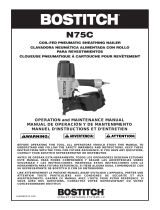
-20-
DIAGNÓSTICO DE FALLA
PPRROOBBLLEEMMAACCAAUUSSAACCOORRRREECCCCIIÓÓNN
Fuga de aire en la envoltura de la Anillo en O cortado o rajado Reemplazar el anillo en O.
válvula disparadora.
Vástago de la válvula disparadora Anillos en O/sellos cortados o rajados. Reemplazar anillo en O/sellos.
tiene fuga de aire.
Fuga de aire en el armazón/nariz. Tornillos de nariz flojos. Apriete y verifique nuevamente.
Anillo en O/empaquetadura cortada o rajada Reemplazar el anillo en O o empaquetadura
Amortiguador rajado/desgastado. Reemplazar el amortiguador.
Fuga de aire en el armazón/tapón. Empaquetadura rajada. Reemplazar la empaquetadura.
Amortiguador de la válvula de cabeza rajado/desgastado.
Reemplazar el amortiguador.
Tornillos de tapa flojos. Apriete y verifique nuevamente.
No desempeña su ciclo. Restricción en el suministro de aire.
Verifique el equipo de suministro de aire.
Herramienta seca, falta de lubricación. Utilice el Lubricante para Herramientas
Neumáticas de BOSTITCH.
Anillos en O de la válvula de cabeza desgastados.
Reemplazar los anillos en O.
Resorte de la tapa del cilindro roto.
Reemplazar el resorte de la tapa del cilindro
Válvula de cabeza atorada en el tapón. Desensamblar/Verificar/Lubricar.
Falta de potencia Herramienta seca, necesita lubricación. Utilice el Lubricante para Herramientas
Desempeña su ciclo lentamente Neumáticas de BOSTITCH.
Resorte de la tapa del cilindro roto. Reemplazar el resorte de la tapa.
Anillos en O/sellos cortados o rajados. Reemplazar los anillos en O/sellos.
Escape bloqueado Verificar el amortiguador, resorte de la
válvula de cabeza.
Ensamblaje del gatillo desgastado/tiene fugas. Reemplazar el ensamblaje del gatillo.
Acumulación de polvo/alquitrán en impulsor. Desensamblar la nariz/impulsor para limpiar
La manga del cilindro no está asentada Desensamblar para corregir.
debidamente en el amortiguador de abajo.
Válvula de cabeza seca. Desensamblar/lubricar.
Presión de aire demasiado baja. Verifique el equipo de suministro de aire
Sujetadores que saltan. Amortiguador desgastado. Reemplazar el amortiguador.
Alimentación intermitente Alquitrán/polvo en el canal del impulsor.
Desensamblar y limpiar la nariz y el impulsor
Restricción de aire/flujo de aire inadecuado a través Reemplazar los accesorios de desconectado
del casquillo y tapón de desconectado rápido. rápido.
Anillo en O de pistón desgastado. Reemplazar el anillo en O, verificar el impulsor
Herramienta seca, necesita lubricación. Utilice el Lubricante para Herramientas
Neumáticas de BOSTITCH.
Resorte de empuje dañado. Reemplazar el resorte.
Baja presión de aire. Verifique el sistema de suministro de aire
a la herramienta.
Tornillos flojos en la nariz del cargador. Apriete todos los tornillos.
Los sujetadores son demasiado cortos Use sólo los sujetadores recomendados.
para la herramienta.
Sujetadores doblados. No use estos sujetadores más.
Sujetadores de tamaño equivocado. Use sólo los sujetadores recomendados.
Empaquetadura de la tapa de cabeza con fugas. Apriete los tornillos/Reemplazar la
empaquetadura.
Anillo en O de la válvula del disparador cortado/ Reemplazar el anillo en O.
desgastado.
Impulsor roto/quebrado. Reemplazar el impulsor.
(Verificar el anillo en O del pistón).
Cargador seco/sucio. Limpiar/Lubricar. Utilice Lubricante para
Herramientas Neumáticas de
BOSTITCH.
Cargador desgastado. Reemplazar el cargador.
Los sujetadores se atoran en la herramienta Canal del impulsador desgastado. Reemplazar la nariz/Verificar la puerta.
Sujetadores de tamaño equivocado. Use sólo los sujetadores recomendados
Sujetadores doblados. No use estos sujetadores más.
Tornillos flojos en el cargador/la nariz. Apriete todos los tornillos.
Impulsor roto/quebrado. Reemplazar el impulsor.
CLAVADORAS DE BOBINA
Sujetadores que saltan Pistón alimentador seco. Agregue el Lubricante para Herramientas
Alimentación intermitente Neumáticas de BOSTITCH
en el orificio de la tapa del pistón
alimentador
Anillos en O del pistón alimentador quebrados/ Reemplazar los anillos en O/Verificar el
desgastados.
amortiguador y el resorte. Lubricar el ensamblaje
Inspeccione el trinquete para ver si se atasca. Revise el trinquete y el resorte de la
puerta. Deben funcionar libremente.
Parte inferior del cargador no está fijada Ajuste la parte inferior del cargador
correctamente. para el largo de clavos que se está
utilizando.
Alambres de soldadura rotos en rollo del clavo. Discontinúe su uso.
Los sujetadores se atoran en la herramienta/ Sujetadores de tamaño equivocado para Use sólo los sujetadores recomendados.
cargador. la herramienta Verifique el ajuste del fondo del cargador.
Alambres soldados rotos en rollo del clavo. Discontinúe su uso.
Ajuste equivocado de placa deslizante para Ajuste las clavijas del ajustador para el rollo
rollo de clavos de alambre/plástico de clavos de alambre/plástico.




















